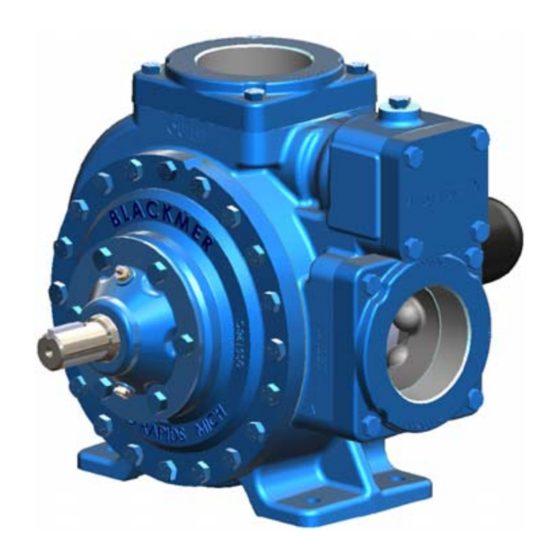Dover Blackmer LGL3021A 설치, 작동 및 유지보수 지침 - 페이지 7
{카테고리_이름} Dover Blackmer LGL3021A에 대한 설치, 작동 및 유지보수 지침을 온라인으로 검색하거나 PDF를 다운로드하세요. Dover Blackmer LGL3021A 12 페이지. Liquefied gas pumps

A drive shaft guard between the pto and
pump must be provided to prevent
personal injury, property damage, or
death.
Do not operate
without guard
in place
Figure 7 – Pump Drive
Note: A Drive Shaft Guard between the pump and the
PTO MUST be provided. (Not Shown)
Angle of Drive Shaft
1° through 5°
6° through 10°
Very good
HYDRAULIC DRIVE
truck mounted pumps may also be driven hydraulically.
Hydraulic motors must be well supported with their shafts
parallel to the pump shaft in all respects. Blackmer provides
an optional close-coupled hydraulic motor adapter. The
adapter provides for straight alignment of a hydraulic motor
drive through a solid coupling connected to a straight key
pump shaft. This coupling connection requires grease
lubrication every three months at minimum. See the
"Lubrication" section of this manual.
Operation without shaft protector can
cause serious personal injury, major
property damage, or death.
Do not operate
without guard
in place
PRE-START UP CHECK LIST
Check the alignment of the pipes to the pump. Pipes
1.
must be supported so that they do not spring away or
drop down when the pump flanges or union joints are
disconnected.
2.
Install pressure gauges in the 1/4" NPT ports located on
the pump casing. These can be used to check the actual
inlet and discharge conditions after pump start-up.
3.
Inspect complete piping system to ensure that no piping
loads are being placed on the pump.
4.
Secure appropriate hose connections.
TRUCK MOUNTED PUMPS
11° through 15°
Good
Fair
Table 2
START UP PROCEDURES
Consult the "General Pump Troubleshooting" section of
this manual if difficulties during start up are experienced.
Hazardous pressure
can cause personal
injury or property
damage
1.
Open the shut-off valve in the bypass return line.
2.
If the tank outlet valve is:
a.
Lever Operated - Pull the control knob all the way
out. Manually check the lever under the truck to see
that it is in the completely OPEN position.
b.
Discharge Pressure Operated - Keep the discharge
line valve closed. When pump is started, it will build up
enough pressure to open the tank outlet valve. NOTE:
This type of valve usually requires approximately 20
PSI (1.4 bar) differential pressure to open and
approximately 15 PSI (1.0 bar) differential pressure to
keep it open. If the piping is quite large, it may be
necessary to restrict the discharge line shut-off valve
in order to maintain sufficient pressure to keep the
tank outlet valve open.
3.
Start the pump. Confirm proper pump rotation by checking
the pump rotation arrows.
4.
Check the pump speed. Pump speed must never exceed
the recommended maximum. See "Technical Data" section
of this manual.
5.
Check the pressure gauges to ensure the system is
operating within expected parameters. Record the gauge
readings in the "Initial Start Up Information" section of this
manual for future reference.
6.
Inspect piping, fittings, and associated system equipment
for leaks, noise, vibration and overheating.
7.
Check the flow rate to ensure the pump is operating within
the expected parameters. Record the flow rate in the
"Initial Start Up Information" section of this manual for
future reference.
8.
Close the discharge valve and check the differential
pressure across the pump. It must not exceed the pressure
setting of the external bypass valve.
9.
With the discharge valve still closed, momentarily close the
manual shut-off valve in the bypass return line to check the
internal pump relief valve. The differential pressure should
be between 150 and 170 PSI (10.3 and 11.7 bar).
10. The external bypass valve must always be set at least 25
PSI (1.7 bar) lower than the pump internal relief valve.
NOTE: The normal operating pressure must be at least 5 -
15 PSI (0.3 - 1.0 bar) less than the external bypass valve
setting. Pump speeds which result in higher pressures
(nearing the valve setting) forces the liquid to recirculate,
creating excessive wear on the pump and equipment.
501-L00
Page 7/12
NOTICE:
Pumps operating against a closed valve
can cause system failure, personal
injury and property damage
